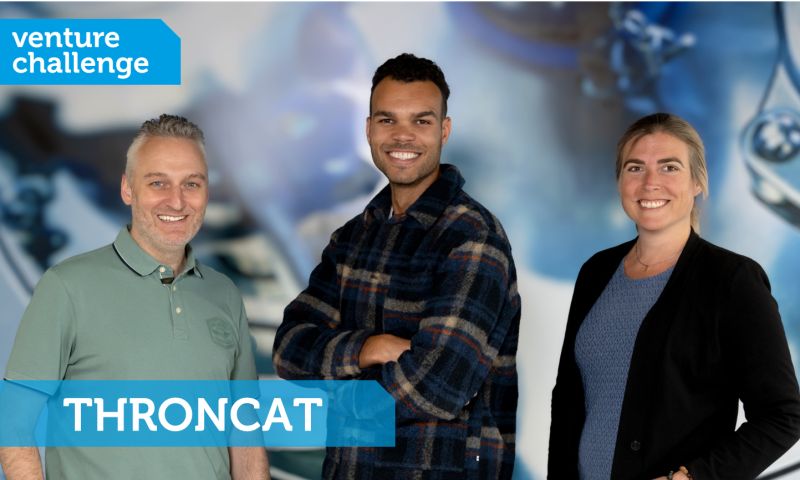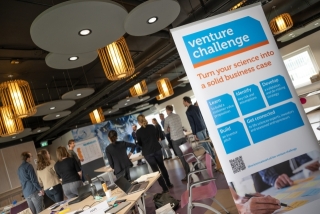These are the Venture Challenge Spring 2024 teams!
Six teams have started the Venture Challenge Spring 2024! Between 6 May and 28 June these starting lifesciences entrepreneurs will learn everything there is to know about building and pitching a businessplan. By participating in the Venture Challenge, the teams will get a tremendous boost to get their idea to the next level. Not only will they receive one-on-one coaching, but they will also get the opportunity to pitch to investors and connect with seasoned entrepreneurs.
The teams:
THRONCAT - Illuminating the cellular proteome
Analyzing changes in protein levels is crucial for scientists studying diseases and developing treatments. Current methods to measure protein synthesis and degradation lack sensitivity and ease of use, limiting researchers' capabilities. THRONCAT's solution uses a new molecule called β-ethynyl serine (βES) to label proteins, enabling simple and sensitive profiling of both protein synthesis and degradation. This method is much more sensitive and versatile than existing ones, allowing scientists to study diseases more effectively. βES is already gaining popularity in the research community, and we believe it will become the new standard for protein analysis in life sciences.

From left to right: Frits Mattijssen, Bob Ignacio, Kim Bonger
Myonovum 2.0 - Redefining neuromuscular drug development with advanced tissue models
Leveraging a three-dimensional in vitro muscle model methodology developed at Erasmus MC, Myonovum plans to offer advanced analysis services to pharmaceutical and biotech companies focused on neuromuscular disease drug development. They aim to generate superior-quality human induced pluripotent stem cells (hiPSCs)-derived myogenic cell lines, enabling the creation of high-quality 3D Tissue Engineered Skeletal Muscles (3D-TESMs) for disease modeling and drug testing. In the future, customers will be able to purchase cells from our portfolio or request specific cell lines for particular diseases or phenotypes. Additionally, we plan to establish an in-house service for drug and therapy testing on 3D-TESMs for both muscle and heart applications. Myonovum's goal is to accelerate the development of improved therapies, reducing costs and significantly enhancing patient care.

From left to right: Jelle Eikelhof, Lisa Kleinjan, Alessandro Iuliano
Twente Medical Optics - We set the new standard in perfusion imaging, anytime, anywhere!
Blood perfusion is vital for maintaining healthy human tissue and aiding in healing processes. Abnormally enhanced perfusion can indicate underlying pathological conditions, making accurate measurement critical for effective diagnosis and treatment. The University of Twente has addressed this challenge by developing the HAPI device. Our mission is to bring HAPI to market to enhance patient care. This device is lightweight, accurate, swift in diagnosis, contactless, and versatile across various clinical specializations.

From left to right: Kiki Liu, Wiendelt Steenbergen, Anne Rook
MaTiReX - Plugging fetal membranes to give babies a fair chance at life
MaTiReX’s innovative collagen plug addresses an important need in minimally invasive fetal surgery. When small defects are made in the fetal membranes to treat an unborn child, they cannot be closed, posing a significant risk of extreme preterm birth and associated complications. To mitigate these risks, we have developed an expandable collagen plug that fits through endoscopic instruments and expands after application. This plug seals the defect and enables tissue regeneration, reducing the inherent risks of fetal surgery. By improving safety, our device may facilitate fetal surgery for a wider range of conditions.
 From left to right: Lieke van Dommelen, Rob Meuwese, Willeke Daamen
From left to right: Lieke van Dommelen, Rob Meuwese, Willeke Daamen
QTM BioSciences - Aiming to contribute to more effective drugs, QTM BioScience’ technology provides the last mile of a drug’s journey to its target by visualizing its distribution inside a cell
A drug’s journey is currently understood only up to the organ level, lacking information on actual concentrations at cellular targets. This gap can lead to incorrect predictions of drug efficacy and safety. Understanding subcellular concentrations is crucial for novel drug classes with poor membrane permeability and advanced delivery systems. With 50% of drug targets located in organelles, subcellular distribution is vital and relies on membrane protein transport.
QTM BioSciences provides insights into a drug’s journey inside cells, de-risking and enhancing drug development efficiency. Our services aim to improve translation from in vitro results to clinical trials, accelerating discovery, reducing costs, and minimizing unnecessary human and animal studies.

From left to right: Britta Driessen, Tom Schirris
The next team will be introduced here soon!

